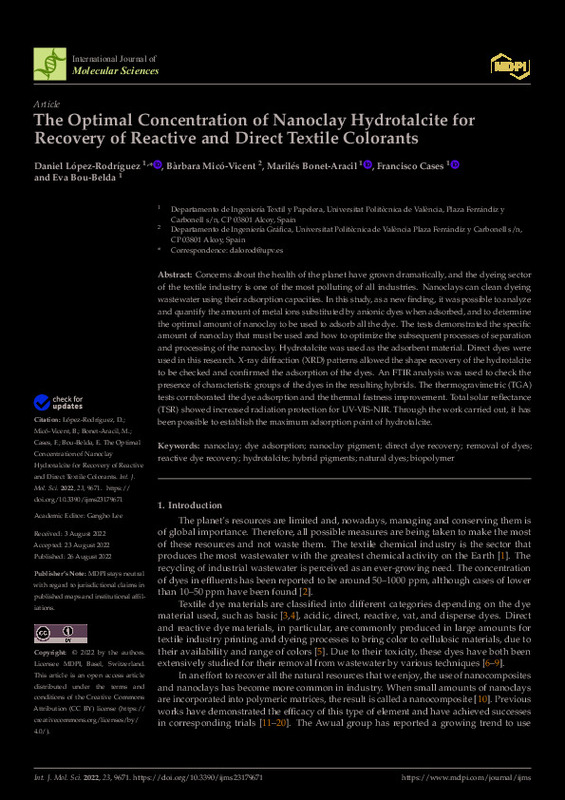

Listar por palabra clave "Dye adsorption"
RiuNet: Repositorio Institucional de la Universidad Politécnica de Valencia
- RiuNet repositorio UPV
- :
- Listar por palabra clave
JavaScript is disabled for your browser. Some features of this site may not work without it.
Buscar en RiuNet
Listar
Mi cuenta
Ayuda RiuNet
Admin. UPV
Listar por palabra clave "Dye adsorption"
Mostrando ítems 1-7 de 7
-
López-Rodríguez, Daniel; Micó-Vicent, B.; Jordán-Núñez, Jorge; Montava-Seguí, Ignacio; Bou-Belda, Eva (MDPI AG, 2023-07)[EN] Clays are considered great nanoadsorbents for many materials, including textile dyes. The use of these materials for cleaning textile wastewater is well known; however, it is not at all common to find applications for ...
-
López-Rodríguez, Daniel; Jordán-Núñez, Jorge; Gisbert Paya, Jaime; Díaz-García, Pablo; Bou-Belda, Eva (MDPI AG, 2023-01)[EN] Textile effluents are among the most polluting industrial effluents in the world. Textile finishing processes, especially dyeing, discharge large quantities of waste that is difficult to treat, such as dyes. By ...
-
López-Rodríguez, Daniel; Jordán-Núñez, Jorge; Micó-Vicent, B.; Belda, Antonio (Elsevier, 2024-12)[EN] This work deals with the synthesis of hybrids formed by the natural dye chlorophyll and halloysite for their subsequent application in the textile field. Once the pigments have been synthesised, with 98% adsorption, ...
-
López-Rodríguez, Daniel; Micó-Vicent, B.; Jordán-Núñez, Jorge; Moncho-Santonja, María; Bou-Belda, Eva (Elsevier, 2023-02)[EN] By using nanotechnologies it is possible to colour textile substrates with new printing techniques using dyes that have been discarded from non-exhausted dye baths. Hydrotalcite is clay with a high adsorbent capacity ...
-
López-Rodríguez, Daniel; Jordán-Núñez, Jorge; Micó-Vicent, B.; Llinares Llopis, Raúl; Moncho-Santonja, María (Elsevier, 2023-11-03)[EN] There is growing concern about the health of our planet, which has led to a search for meth-ods to purify and recover the pollutant materials that are released into the environment.Among all industries, the dyeing ...
-
López-Rodríguez, Daniel; Micó-Vicent, B.; BONET-ARACIL, MARILÉS; Cases, Francisco; Bou-Belda, Eva (MDPI AG, 2022-09)[EN] Concerns about the health of the planet have grown dramatically, and the dyeing sector of the textile industry is one of the most polluting of all industries. Nanoclays can clean dyeing wastewater using their adsorption ...
-
López Rodríguez, Daniel; Micó Vicent, Bárbara; Bonet Aracil, María Angeles; Cases Iborra, Francisco Javier; Bou Belda, Eva (Universitat Politècnica de València, 2022-08-26)Concerns about the health of the planet have grown dramatically, and the dyeing sector of the textile industry is one of the most polluting of all industries. Nanoclays can clean dyeing wastewater using their adsorption ...
Mostrando ítems 1-7 de 7

Universitat Politècnica de València. Unidad de Documentación Científica de la Biblioteca (+34) 96 387 70 85 · RiuNet@bib.upv.es









